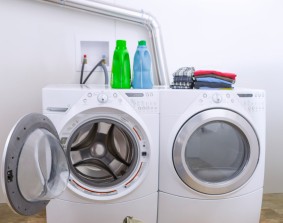by JT Gonzales, http://www.angieslist.com/articles/5-parts-can-lead-washer-or-dryer-repair.htm
Washers and dryers are built to last a good number of years, and when properly maintained they can last even longer. Be aware of these parts and keep an eye out for signs of trouble. If the issues are addressed early, your machines will wash and dry your clothes effectively for a long time.
A bad motor
One common reason for contacting a washer-dryer repair service is a bad motor. A professional should always replace motors that fail to turn on. Under constant and heavy use, motors can sometimes overheat and stop working for a moment. If you give the appliance enough time to cool down, it will begin to work again, but the fact that it overheated is a warning sign that the motor is going bad and needs attention from a repair professional.
A bad coupler can cause a motor to begin to malfunction. This part connects the motor to the washer’s transmission. Since the part is usually made of plastic or rubber, it can break quite easily. When this happens, you need to replace it; otherwise, the motor will not function in the same way.
Even when the motor is going bad, the problem may not be obvious to the untrained eye. For example, on traditional washing machines, the tub moves in opposite directions to wash clothes, but even when the motor goes bad, it will still move, except only in one direction.
The water pump
In a washer, the water pump circulates and drains water. Water pumps are usually made of plastic and can break easily. A pump also can develop a bad seal and begin dripping water from the bottom of the washing machine, leaving you with a mess.
If the water pump develops a blockage, it can’t circulate water. If the belt wears out or breaks in water pumps driven by a belt, the pump will stop working altogether.
The belt
A bad belt will also prevent a washer’s tub from moving. When the belt wears out, it slips while working its way through the washer’s pulleys.
In a dryer, a bad belt will keep it from working completely. The machine will sound like it’s functioning normally, but the drum full of wet clothes won’t spin.
Seals and gaskets
Bad gaskets, especially those that keep heat or water from escaping, will lead to an ineffective machine. Gaskets around a dryer’s door keep heat from escaping and allow the machine to dry clothes efficiently. Almost all gaskets in a washer, especially those on the door of a front-load washer, keep water from leaking. Also, the tub has a main seal that, when it goes bad, begins to leak water.
Heating element and thermal fuse
In a dryer, a heating element (or igniter) helps the machine produce heat to dry wet clothing. If it breaks or goes bad, the dryer will produce little or no heat. A heating element is typically used in electric dryers and can burn out or break. An igniter is used in gas dryers to light up the gas that produces heat, and if it fails to do so, the machine will not dry your clothes.
A thermal fuse in a dryer prevents the machine from getting too hot or working at all. If you notice the dryer overheating or burning your clothes, stop using the machine and call an experienced repairman. If left untreated, a bad thermal fuse can even lead to a fire.
According to HomeWarrantyWiz.com, washers and dryers operate normally for 12 to 14 years.
